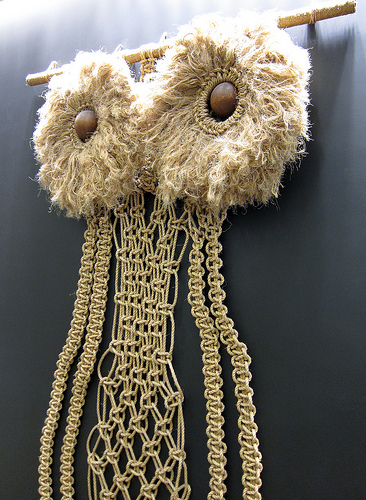
In the 1960s and 1970s, one of the most popular crafts in America was macramé. This is as unaccountable a fad as disco or Pet Rocks. What could have possessed perfectly intelligent, sane, ordinary people to buy loads of rough hemp rope, giant beads the size of your thumb, and patterns for tying said rope into decorative knots and patterns? (This page says that macramé is "once again increasing in popularity." I'm scared.)
Just hearing the word "macramé" gives me a vivid pair of sensory memories: the scratchiness of the rope, and its dusty smell. Did any house in the 70s escape this scourge of misbegotten crafts? And is there anything more dismal than the sorry, bedraggled tassel that comes from deliberately fraying the end of a length of hemp rope?
Most macramé crafts were strictly decorative. One of my rules for making a craft is that it has to be useful. Macrame fails that test, and it fails it badly. There is only one thing useful you can make with macramé, and that's a hanging potted plant holder. And even so, this is an item of dubious utility at best. I know everyone had tons of house plants in the 70s, but how many hanging potted plant holders does a person need, anyway?
When I was a kid, my friend's living room windows were decorated with macramé curtains. They were as impractical as they were ugly. They didn't block the view or the light in either direction, and they were impossible to clean, thus befurred with years of accumulated dust and cigarette smoke. (Everyone smoked in the 70s, and everyone smoked inside.)
The only good thing I have to say about macramé is that it frequently involved owls, which were hot icons of pop art at the time. And macramé owls are - I must begrudgingly admit - pretty awesome.
Image courtesy Flickr/Scott Beale

2 comments